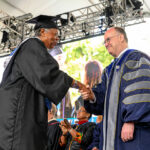
The MERIT Team

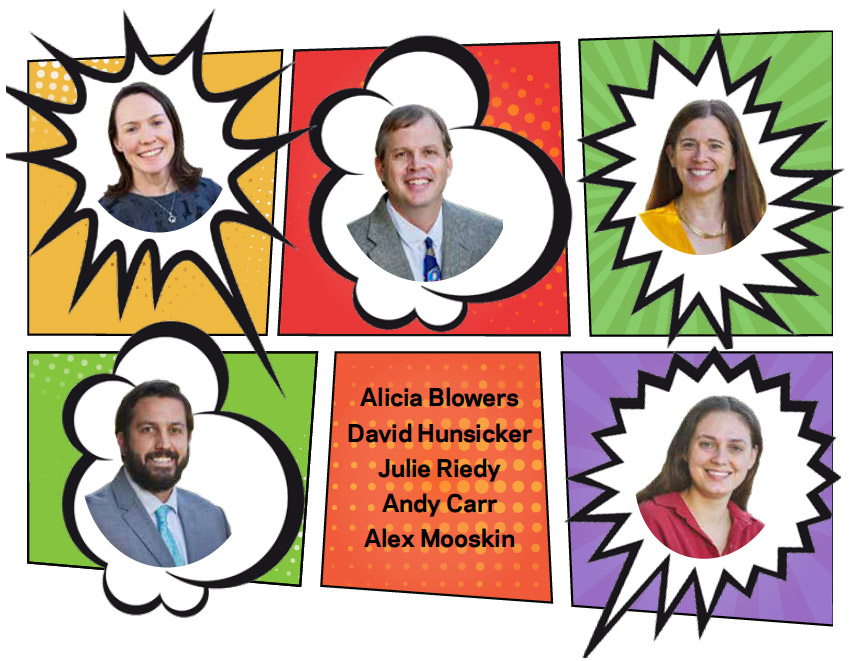
There is a special team of people working behind the scenes at the Middle School. They are the unsung tech wizards who help support the Middle School’s technology curriculum integration program. They are…
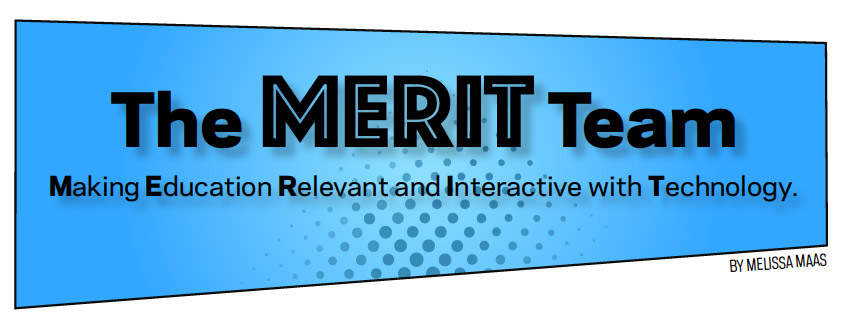
As St. Stephen’s and St. Agnes prepared to implement a 1:1 technology program in 2015, Middle School Technology Education Coordinator David Hunsicker wondered how he would manage adding nearly 300 laptops to the list of devices already maintained by the technology team – including the faculty laptops, loaner laptop carts, and lots of iPads. As the smallest division with around 40 faculty and staff and just under 300 students, David was spending half his time working with a full-time tech support staff member to handle all the technology needs in the Middle School. Anticipating the demands of going 1:1, they put their heads together to figure out how they could make the tech education side a little more robust.
The answer came through a session David attended at the 2015 National Association of Independent Schools Conference in Boston. “The Hun School of Princeton had already gone 1:1 and hosted a session on their process, “’How to Simplify Managing Your School’s IT in the Age of 1:1,’” David said. “They outlined a model I thought would work well for us, offering a stipend to four tech savvy teachers who would be interested in helping us transition to a 1:1 program in the fall of 2016, and then continue serving as tech support for the faculty.” Once the idea had been discussed and formalized, David emailed the faculty looking for teachers with a love of technology and bringing new technology projects into the curriculum—and the MERIT team was born. The current team led by David is Julie Riedy (math teacher), Andy Carr (history teacher), Alicia Blowers (librarian), and Alex Mooskin (science teacher). Julie and Alicia have been on the team since its inception and it’s the first year on board for Andy and Alex.
Serving as Faculty Technology Liaisons
One of the most valuable aspects of the role of the MERIT team is their support of the ed tech program and participation in planning discussions with the administration and the Information Technology department. The MERIT team meets on a bi-weekly basis with Associate Director of the Middle School Josh Bauman, Information Technology Director Colleen McNeil, Associate Director of Information Technology David Nadelhoffer, and Director of Teaching and Learning Lana Shea. Julie believes that the most important role she plays as a MERIT team member is offering her perspective as a teacher. “The MERIT Team helps with policy, like a tech think tank,” Julie said. “As policies are formed, professional development is created, and ideas are discussed, I feel it’s important to have all viewpoints represented, including an administrator, the IT director, and the teachers who put everything into practice.”
Another key function of the MERIT team is to evaluate new technologies that have been requested by faculty members, to ensure that the school is making the wisest investment of time and resources. “We want to protect our students and give them safe resources,” Julie said. “So, before a teacher can use a new program, it has to be requested. The team evaluates it for safety, ease of use, and to make sure we’re not using multiple platforms that do the same thing.” If a teacher requests a program, but if the MERIT team thinks there is a comparable one that is more universal, they encourage the teacher to try it and give them the training and support they need to learn and use it.”
MERIT members also help to pilot new programs, plan implementation, and develop training materials to share with faculty. They foster new tech projects for the curriculum and make sure they meet the International Standards for Technology Education (ISTE). They actively participate in their own professional development, attending (and presenting at) technology conferences, as well as researching new advances in the field of ed tech in order to bring the best tools to the teachers. They also help the students take ownership of their digital lives, by curating a digital citizenship curriculum taught during advisory.

Digital Citizenship Program: Helping Students Navigate Digital Media and the Internet
Digital citizenship is about so much more than just being safe online. It’s about using technology in responsible and constructive ways—to make our community better, to engage respectfully online with people who have different perspectives, and to connect with communities beyond the classroom.
As the Middle School librarian, Alicia Blowers was inspired to join the MERIT Team, “I studied educational technology as part of my graduate degree—school library and school technology kind of go hand in hand,” Alicia said. “Since I teach research and website and resource evaluation, being a team member gives me an extra impetus to stay up on the latest trends, it just naturally comes together.”
Alicia heads up the Digital Citizenship Program for the team. “There’s all this technology all around us and the kids have so much access,” Alicia said. “It’s our job to figure out how to take advantage of it, how much to restrict it, and how to make it purposeful.”
Using a curriculum produced by Common Sense Media (CSM)—a non-profit dedicated to helping children thrive in a world of media and technology—she and the team develop a curriculum and a series of lessons that all Middle School students participate in with their advisors. “One of my main roles on the MERIT Team is to preview the 45-minute lessons provided by CSM, looking at the key things we want to get out of it and paring it down to work within the 30-minute time allotted for advisory.” Alicia explained. “The advisors teach the lessons.”
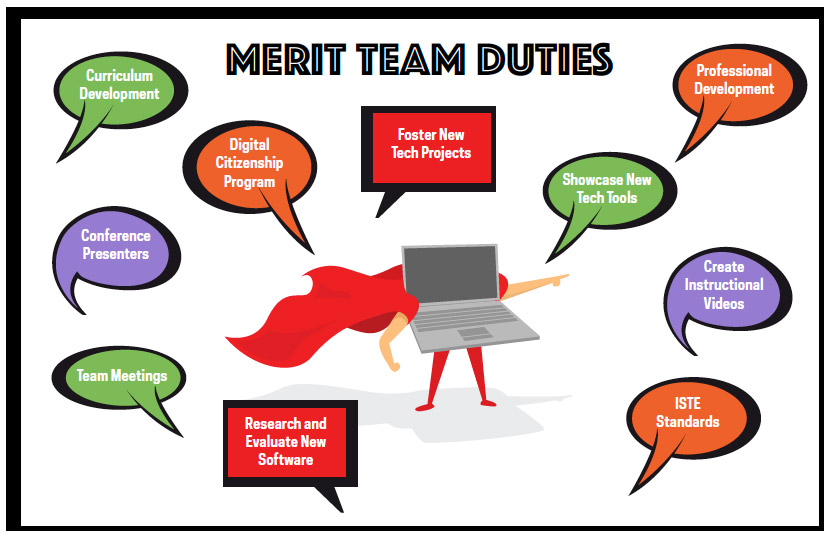
CSM breaks the lessons down into six categories: media balance and well-being; privacy and security; digital footprint and identity; relationships and communication; cyberbullying, digital drama, and hate speech; and news and media literacy. In age-appropriate formats, the individual lessons teach students everything from how companies use their data and phishing scams to thinking about who they are online and how social media affects our relationships. The lessons also cover how to respond to online hate, sexting, and relationships and the power of digital footprints and finding credible news on the Internet.
The MERIT team crafts videos, slides, lesson plans, and follow-up surveys to ensure that our students are prepared to be successful in our increasingly complex digital world. The Middle School digital citizenship curriculum includes an annual parent evening session, where families experience some of the highlights and can learn about best practices for raising teens on technology.
Battle Stations:
Meeting the Challenges of Going Virtual
The primary focus of the MERIT team is faculty professional development, with the goal of helping to support the Middle School’s technology curriculum integration program. MERIT team members help host faculty workshops on topics like Zoom, Google Apps, Class Pages (on the SSSAS website), Screencasting, and other technology related topics and tools, to help enrich the curriculum. The pandemic brought an explosion in the use of technology, and the MERIT team has been essential in getting the Middle School faculty up to speed on tools that can help facilitate teaching and learning in the many different scenarios and phases of our distance learning plan. Not only did the MERIT team jump into action when it became clear the school could shut down, but they had already been key players in the successful transition to distance learning by preparing and encouraging teachers to explore and learn about these technologies over the course of the last four years.
When COVID hit, the team locked themselves in a small room to reflect and brainstorm a set of guidelines and create a unified approach for communicating with students and families for the Middle School faculty. “Every day on our internal website for students and parents, the teachers post what they’re going to be doing in class, what materials the student needs, and what the homework is on their individual online ‘Bulletin Boards,’” Julie said. “The communications are very clear and the same for every teacher.”
The MERIT team also created a plan for providing the faculty with the necessary tools and professional development to hit the ground running. “We put together a learning experience for the faculty members that allowed them to see new teaching tools, practice with those tools, and make some strong strides in being confident with them,” Andy recalled. “It was a professional development experience in which the teachers became the students—learning, exploring, and using new tools they had never seen before. It was a powerful experience and a great reminder of what it is like to be a student in the classroom.”
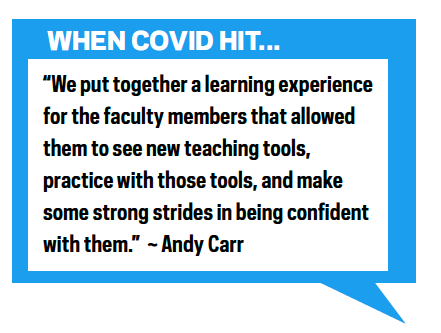 A critical piece of the distance learning puzzle was choosing a meeting platform to use. Since the school uses the Google programs, they started with Google Meet thinking it was the most expedient way to go. “We quickly ran into some problems, but pivoted well to using Zoom,” David said. “It wasn’t that different to go to Zoom and it offers some things that Google Meet doesn’t, like the breakout rooms for smaller group discussions.” Another challenge was the sheer number of users on the Internet at one time, which overpowered the bandwidth.
A critical piece of the distance learning puzzle was choosing a meeting platform to use. Since the school uses the Google programs, they started with Google Meet thinking it was the most expedient way to go. “We quickly ran into some problems, but pivoted well to using Zoom,” David said. “It wasn’t that different to go to Zoom and it offers some things that Google Meet doesn’t, like the breakout rooms for smaller group discussions.” Another challenge was the sheer number of users on the Internet at one time, which overpowered the bandwidth.
Distance learning required some immediate research into finding a versatile format for sharing and assessing assignments and projects. “We found a new platform called Go Formative, an online resource where teachers can have students take assessments; give them immediate feedback; use pre-existing worksheets and see students interacting with them in real time; and track student progress,” Julie said. “The teacher’s comments can be typed or audio. It’s an incredible platform for distance learning that may continue to be very useful.”
When the school shifted from distance learning to hybrid learning, the MERIT team stepped up to the plate again, ready for action. “I think that our biggest contributions by far over the last year have been preparing the faculty for distance learning and then for hybrid learning,” David said. “We had to search for the best possible platforms and programs, create instruction videos and slideshows, prepare cohesive and consistent guidelines, and then deal with all the challenges involved with setting up the classrooms for hybrid learning, whether they were indoors or outdoors, making sure it would work for the students at home as well as the students in the classroom.”
Now the team is gathering information about what has worked well for teachers this year and the areas in which they may need help or new strategies and technology tools moving forward. “Our goal is to use that feedback to help individuals enhance their classes this spring and also put together some strong professional development opportunities for the summer,” Andy said.
Alicia has been talking with the English teachers about their current and future needs and discovered the pandemic brought them a silver lining. “The English department relies heavily on technology, particularly when they’re annotating the books, poems, and short stories the students are reading,” Alicia said. “But they also give lots of instructive and constructive feedback to students, and technology has really helped them to do it more efficiently.” Since everything went virtual last year, they have discovered the ease of commenting and grading papers through Google docs, instead of asking the students to hand in printed copies. “The students turn in their rough draft for comments and then turn in a final paper in a separate document,” Alicia explained. “This allows the teachers to look back at the comments on the rough draft and see how the student’s developed their papers. It’s a big bonus that all their work is readily available and digitally archived.”
Alex is working on creating a workflow/best practices resource related to tech use and responsibilities for new and existing faculty members. Although in her first year on the team, she has spent the past five years or so creating curriculum to introduce and train sixth graders on how to use their computers effectively. “There are so many things that take the students much longer than they need to,” Alex said. “Anything that we can do to build their confidence with technology gets a gold star in my book!”
Julie is talking to the math and religion teachers about their needs, but she also continues to work on a favorite project she launched in the fall of 2019, the bi-weekly Saints Celebration Newsreel. She wanted to create something that would highlight what our students and faculty are doing on all three campuses and spread some joy within the community. As the Middle School leaders, eighth graders can volunteer to be newscasters while student editors from all three grades compile the news. The newsreel is shown at the Lower School right after their weekly podcast, and Middle and Upper School families can find it on the school’s password-protected Resource Board. “The project continues to expand with more community involvement,” Julie said. “The sixth graders are very enthusiastic about participating and next year we’re hoping to involve some Upper School freshmen and sophomores. We’re encouraging students to create the background music. There are lots of student touches in each production and now that the faculty are aware of it, they send us media from all three divisions. Watching the Newsreel evolve and grow is very rewarding.”
One Thing is Certain for the Future…
The MERIT Team model has been a great success and MERIT Teams now exist on the Lower and Upper School campuses. Technology will continue to change, evolve, and impact the way we teach and learn. Making sure our Saints are fully prepared will require the school to continue to grow and transform along with the inevitable new innovations the future will bring…and the MERIT teams will be there to meet any and all challenges head on and positively utilize whatever technological advances come their way.
They will continue to work quietly and effectively without fanfare, because helping is satisfying and meaningful to them. “I think the most important role of a MERIT team member is just being a true support system for the entire faculty,” Andy said. “Technology is often tricky, so having go-to people on campus to help is a valuable thing. Being able to support other faculty members in their efforts to enhance the classroom experience for the students is rewarding.”
“I think the most important role of a MERIT team member is just being a true support system for the entire faculty.”
– Andy Carr



